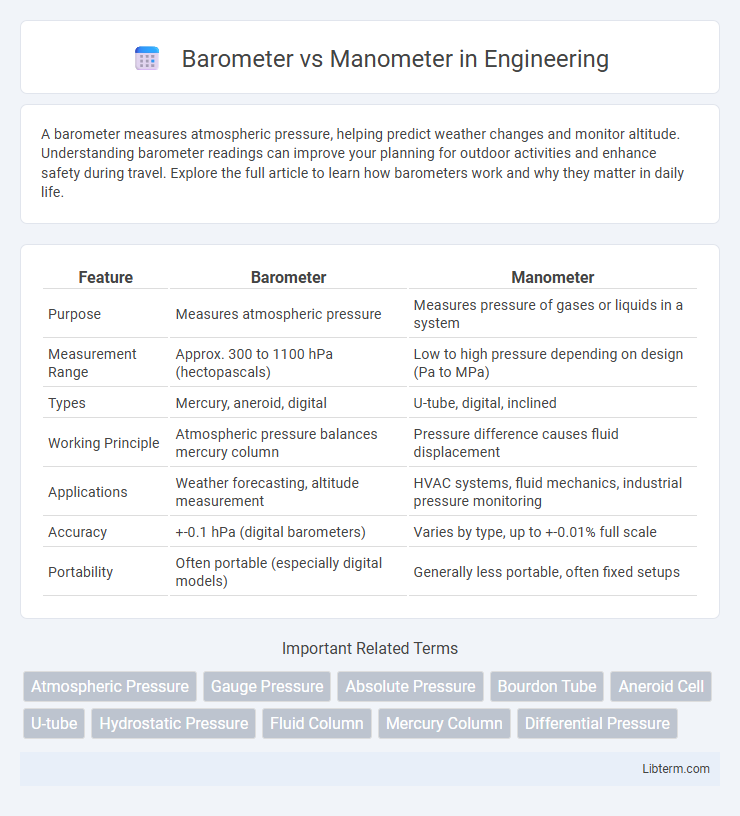A barometer measures atmospheric pressure, helping predict weather changes and monitor altitude. Understanding barometer readings can improve your planning for outdoor activities and enhance safety during travel. Explore the full article to learn how barometers work and why they matter in daily life.
Table of Comparison
| Feature | Barometer | Manometer |
|---|---|---|
| Purpose | Measures atmospheric pressure | Measures pressure of gases or liquids in a system |
| Measurement Range | Approx. 300 to 1100 hPa (hectopascals) | Low to high pressure depending on design (Pa to MPa) |
| Types | Mercury, aneroid, digital | U-tube, digital, inclined |
| Working Principle | Atmospheric pressure balances mercury column | Pressure difference causes fluid displacement |
| Applications | Weather forecasting, altitude measurement | HVAC systems, fluid mechanics, industrial pressure monitoring |
| Accuracy | +-0.1 hPa (digital barometers) | Varies by type, up to +-0.01% full scale |
| Portability | Often portable (especially digital models) | Generally less portable, often fixed setups |
Introduction to Barometers and Manometers
Barometers and manometers are essential instruments used for measuring pressure, with barometers specifically designed to measure atmospheric pressure, while manometers measure the pressure of gases or liquids within a system. Barometers commonly use mercury or aneroid mechanisms to indicate atmospheric pressure changes, crucial for weather forecasting and altitude determination. Manometers, typically U-shaped tubes filled with liquid, provide precise measurements of pressure differences in various scientific and industrial applications.
What Is a Barometer?
A barometer is a scientific instrument used to measure atmospheric pressure, essential for weather forecasting and altitude determination. It typically consists of a column of mercury or an aneroid capsule that responds to changes in air pressure, providing accurate pressure readings. Barometers are crucial for meteorologists to predict weather patterns, especially for detecting changes in storm systems or fair weather.
What Is a Manometer?
A manometer is a device used to measure the pressure of gases or liquids by comparing the fluid column height in a U-shaped tube or other configurations. Unlike a barometer, which measures atmospheric pressure, a manometer specifically measures the pressure relative to the surrounding environment, often used in laboratories and HVAC systems. Common types of manometers include simple U-tube manometers, digital manometers, and inclined manometers, each providing precise pressure readings for various applications.
Key Differences Between Barometers and Manometers
Barometers measure atmospheric pressure using a column of mercury or aneroid cells, essential for weather forecasting and altitude determination. Manometers quantify pressure differences in gases or liquids, often employing U-shaped tubes filled with fluid to detect pressure changes in closed systems. The key difference lies in barometers assessing absolute atmospheric pressure, while manometers measure relative pressure variations within controlled environments.
Types of Barometers
Barometers are primarily classified into mercury barometers, aneroid barometers, and digital barometers, each offering unique measurement methods for atmospheric pressure. Mercury barometers use a column of mercury that rises and falls with pressure changes, ideal for high-precision readings. Aneroid barometers measure pressure via a flexible metal chamber that expands or contracts, while digital barometers utilize electronic sensors for accurate, real-time data.
Types of Manometers
Manometers come in several types, including U-tube, inclined, and digital manometers, each designed for precise pressure measurements in different applications. U-tube manometers, filled with liquid like mercury or water, measure pressure differences based on fluid displacement, while inclined manometers enhance sensitivity for low-pressure readings. Digital manometers utilize electronic sensors, offering high accuracy and ease of use, making them suitable for modern industrial and HVAC systems.
Applications of Barometers
Barometers primarily measure atmospheric pressure, essential for weather forecasting, aviation, and altitude determination. Meteorologists rely on barometers to predict storms and monitor climate changes, while pilots use them for accurate altitude readings during flight. Barometers also assist hikers and mountaineers in estimating elevation and anticipating weather conditions in remote areas.
Applications of Manometers
Manometers are widely used in HVAC systems to measure gas pressure differences and ensure proper airflow and ventilation. They are essential in laboratory settings for precise measurement of fluid pressures in experiments and calibration of pressure sensors. Industrial applications include monitoring pressure in pipelines, boilers, and gas supply systems to maintain safety and operational efficiency.
Accuracy and Calibration: Barometer vs Manometer
Barometers typically offer higher accuracy in measuring atmospheric pressure due to their use of mercury or aneroid mechanisms calibrated against international standards. Manometers, designed primarily for measuring differential or gas pressure, require frequent recalibration to maintain precision, especially when exposed to varying temperature and fluid density conditions. Calibration procedures for both instruments involve comparison to known pressure references, but barometers benefit from more stable baselines, resulting in less frequent adjustments.
Choosing Between a Barometer and a Manometer
Choosing between a barometer and a manometer depends on the measurement context; barometers are ideal for measuring atmospheric pressure and weather forecasting, while manometers excel in measuring pressure differences in gases or liquids within confined systems. Barometers, typically mercury or aneroid types, provide absolute pressure readings essential for meteorological applications. Manometers, often U-tube or digital, offer precise differential pressure data critical for HVAC systems, laboratory experiments, and industrial processes requiring accuracy in pressure variations.
Barometer Infographic

 libterm.com
libterm.com